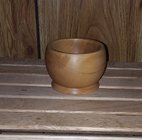- Joined
- Feb 28, 2021
- Messages
- 1,778
- Likes
- 1,592
- Location
- Roulette, PA
- Website
- www.reallyruralwoodworks.com
Well I was re-watching the Rudy Lopez videos from recent online Woodturning Fundamentals sessions (While anxiously awaiting the Ernie Conover ones I really wanted to watch in the first place) .
I got the idea to practice a couple tips of Rudy's and thought I'd shoot for a calabash form - Not having suitable dry blanks, I went with a smaller 4 x 4 maple blank I have had laying around for a couple years.
I was shooting for a Calabash-like form , but I decided I needed it to have a foot if I was going to try and sell it at market (it'd make a nice sized mortar for a Pestle yet to be turned)
I think I got fairly close, but wanted some expert opinions - So, disregarding the foot, how do you think I did at getting the curvature and at least the top 2/3 of a calabash form? (it's just a little over 1/4 inch wall thickness, and inside bottom does continue the curvature for the most part but I have a quarter sized flat spot in the very bottom.)

I got the idea to practice a couple tips of Rudy's and thought I'd shoot for a calabash form - Not having suitable dry blanks, I went with a smaller 4 x 4 maple blank I have had laying around for a couple years.
I was shooting for a Calabash-like form , but I decided I needed it to have a foot if I was going to try and sell it at market (it'd make a nice sized mortar for a Pestle yet to be turned)
I think I got fairly close, but wanted some expert opinions - So, disregarding the foot, how do you think I did at getting the curvature and at least the top 2/3 of a calabash form? (it's just a little over 1/4 inch wall thickness, and inside bottom does continue the curvature for the most part but I have a quarter sized flat spot in the very bottom.)

